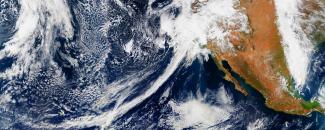New report highlights past, current, and projected climate trends

The U.S. Global Change Research Program’s (USGCRP) Climate Science Special Report (CSSR), which serves as Volume I of the Fourth National Climate Assessment (NCA4), describes current trends in the climate globally and for the United States, and projects trends in temperature, precipitation, sea level rise, and Arctic sea ice for the remainder of this century.
Global and U.S. Temperatures Continue to Rise
-
The annual average temperature for the globe and the contiguous United States has increased 1.8°F from 1901 to 2016.
-
Sixteen of the warmest years on record for the globe occurred in the last 17 years; the last three years were the warmest.
Variability in Temperature and Precipitation is Increasing
-
Heavy precipitation has increased in intensity and frequency across most parts of the United States since 1901, though there are important regional differences.
-
Heatwaves have become more frequent in the United States since the 1960s.
-
Cold temperatures and cold waves have decreased since the early 1900s.
-
Annual trends toward earlier spring snowmelt and reduced snowpack are already affecting water resources in the western United States.
Ocean Temperatures are Warming and an Increase in Sea Level
-
Global average sea level has risen by about 7–8 inches since 1900.
-
Global average sea level is expected to rise by several inches in the next 15 years.
Temperature Increases in Alaska and Across the Arctic are Greater than the Rest of the Globe
-
Annual average near-surface air temperature in Alaska and across the Arctic has increased over the last 50 years at a rate more than twice as fast as the global average temperature.
-
Since the early 1980s, Arctic sea ice extent has decreased between 3.5 percent and 4.1 percent per decade, has become thinner by between 4.3 and 7.5 feet, and on average the season of melting lasts 15 more days per year.
NOAA is one of 13 USGCRP federal agencies that contributed significantly to the CSSR and the draft NCA4.
How NCEI Supports Climate Science and Assessments
Several NCEI scientists served as lead authors and contributing authors for this report. NCEI also supported the development of the assessment through the Technical Support Unit (TSU), which is housed at our headquarters location in Asheville, North Carolina. Members of the TSU—many of whom work with our partner, the Cooperative Institute for Climate and Satellites–North Carolina—helped pull together the knowledge of experts from multiple U.S. Federal agencies to create a scientifically accurate, consistent, and clearly communicated report.
The TSU science team made significant contributions to the climate science results presented in the report, including the development of several figures showing observed and projected changes in key aspects of Earth's climate system.
TSU communications experts provided technical editing, copyediting, graphic design, and layout of the final assessment. The TSU also designed and developed the assessment’s interactive website, which allows you to easily share its findings on social media. Additionally, TSU data experts and software engineers helped ensure openness and transparency in the report by facilitating the collection and delivery of a range of metadata.
A draft of the NCA4 is available for public comment at review.globalchange.gov.



